Havard is one of the few 19th-century Villedieu coppersmiths that survives to this day.
Normandy is named for the Norsemen — Vikings — who invaded the region repeatedly from the end of the 8th century through the 12th century, and Håvard is a Norwegian name. I can find Havards in Normandy in online genealogical records as far back as the 16th century and I’m willing to bet that the family’s history goes back further than that. In 1855, of 69 chaudronniers-poêliers listed in Villedieu, eleven included Havards; in 1898, Havard was named as one of the five grandes familles of Villedieu along with Loyer, Villain, Huard, and Le Moyne (Lemonnier).
History
The bell-making Fonderie Cornille-Havard side of the family traces its history to Adolphe Havard who in 1865 took over a moribund bell foundry outside Villedieu and re-established it at a newly-built workshop. In 1900, Adolphe’s son-in-law Léon Cornille took over the business, and his daughter Marguerite Cornille-Havard followed in his footsteps. In 1981, the family sold the business to Luigi and Françoise Bergamo who operate the foundry to this day.
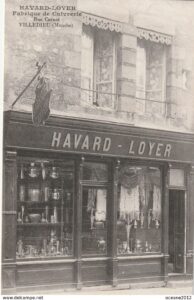 At the end of the 19th century, while Adolphe Havard and Léon Cornille were forging bells, there were at least three other branches of Havards working with copper. Of these, I believe that Eugène-François Havard (b. 1856) built the firm that made copper cookware under the Havard name in the 20th century.
At the end of the 19th century, while Adolphe Havard and Léon Cornille were forging bells, there were at least three other branches of Havards working with copper. Of these, I believe that Eugène-François Havard (b. 1856) built the firm that made copper cookware under the Havard name in the 20th century.
Eugène-François and his wife Marie Lodoïska Loyer built Havard-Loyer, a chaudronnerie that also produced products for the garderobe — sinks and toilets. (We owe Havard-Loyer a debt of gratitude for patenting an early flush toilet.) The firm had a presence in Paris and a shop on Rue Carnot in Villedieu. (Based on the similarity in façades, I believe this shop is currently Cuivrerie Matillon at 3 Rue Carnot.) After Eugène-François passed away in 1911, his son Eugène-Jules Havard (1887-1973) joined the firm but was quickly called to serve in the war from 1914 to 1919.
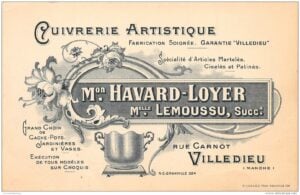 In 1923 the store on rue Carnot was sold to Marie-Louise-Virginie Lemoussu, célibatoire majeure (unmarried but of legal age). The sale of the complete fonds de commerce (foundation of the business) encompassed the store on rue Carnot — described as a Nouveautés, Mercerie, Bonneterie et Objects de Cuivre d’Art (Novelties, Haberdashery, Hosiery and Decorative Copper Objects) — as well as le clientele, l’achandalage, le materièl et les marchandises en magasin (customers, warehouses, materials and goods in the store). A business card of that period identifies Mlle Lemoussu as successeur to Monsieur Havard-Loyer for cuivrerie artistique of fabrication soignée, garantie “Villedieu” (fine manufacturing of guaranteed Villedieu quality).
In 1923 the store on rue Carnot was sold to Marie-Louise-Virginie Lemoussu, célibatoire majeure (unmarried but of legal age). The sale of the complete fonds de commerce (foundation of the business) encompassed the store on rue Carnot — described as a Nouveautés, Mercerie, Bonneterie et Objects de Cuivre d’Art (Novelties, Haberdashery, Hosiery and Decorative Copper Objects) — as well as le clientele, l’achandalage, le materièl et les marchandises en magasin (customers, warehouses, materials and goods in the store). A business card of that period identifies Mlle Lemoussu as successeur to Monsieur Havard-Loyer for cuivrerie artistique of fabrication soignée, garantie “Villedieu” (fine manufacturing of guaranteed Villedieu quality).
My hypothesis is that the Havard family divested itself of that retail storefront to shift their focus to making copper, because Eugène-Jules continued to make copper as Maison Havard (Eugène) Fils. About ten years later, in December 1935, Eugène took a step to expand his business: he formed the société à responsabilité limitée (SARL, equivalent to a limited liability company) Eugène Havard & Cie with a Paris-based partner named Victor Anger. The official company filing shows that Eugène brought to the partnership four things of value from his existing business: his “clientele and goodwill; the name of the business and the positive associations with it; organization and commercial relations; [and] archives and various documents,” cumulatively valued at 50,000 francs. Victor Anger, as co-founder, contributed another 50,000 francs in cash. While Eugene would run the business, Victor’s duties were loosely defined as “customer relations”; my guess is that he was more of an investor whose contribution helped meet capital requirements and gave Eugène some working funds. In any event, Eugène and Victor severed their ten-year agreement in March 1939 after only three years. No debt or conditions of financial settlement were mentioned in the dissolution notice, suggesting to me that Eugène was able to buy Victor out within just a few years.
I don’t know much about the company’s history after 1939. Eugène Havard & Cie operated in Villedieu at Rue Docteur Havard and Rue du Bourg l’Abbesse, as well as in Saultchevreuil du Tronchet just south of town. At some point the company became known as Établissements Havard et fils, perhaps around the time of Eugène’s death in 1973. Établissements Havard et fils persisted at least into the 1980s but by 2001 appears to have been absorbed by Fonderie Cornille Havard. At this moment, Havard cookware is sold at the Cornille Havard factory store attached to the bell foundry in Villedieu.
Havard stamps
I have found seven eight nine different Havard stamp designs, four of which appear to be variations on a design featuring the firm’s Viking ship logo. I will apologize to you right up front: the value of this survey is limited because I don’t know the exact time periods for each one. Seeing all the stamps together, though, tempts me to speculate on their relative age (a temptation I am unable to resist). I’ve reached out to Cornille-Havard to ask for more information on their production and will update this if and when I learn more.
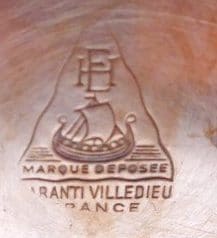 |
Triangle with ship, type IThis design appears in four variants that share the same key elements: a triangular shape; a drawing of a Viking longboat (evoking Havard’s Norwegian origins); mention of Villedieu and France; and the initials “EH,” which I suspect refer to Eugene père et fils who ran the company. This version of this stamp design is distinguished by the curved shape of the Viking ship and the word “France.” I am still trying to date these stamps but my hunch at the moment is that this is the oldest iteration of the triangle-with-ship series. |
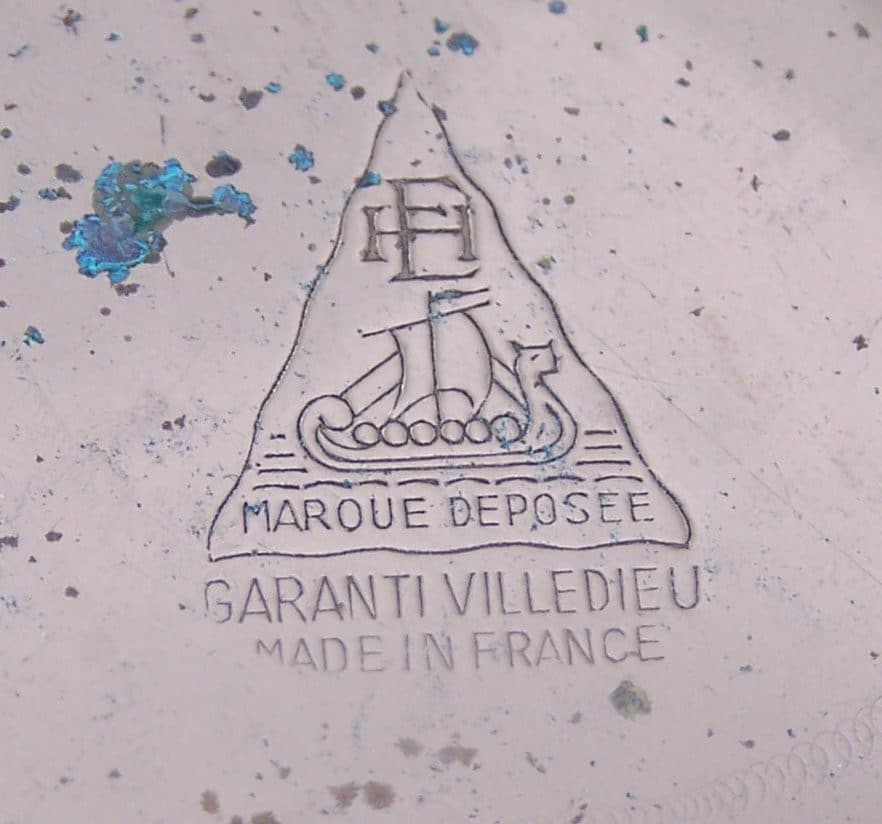 |
Triangle with ship, type IIThis stamp has a Viking ship with a linear shape. The ship is also drawn more like a cartoon with a pronounced dragon figurehead. There is also a full “Made in France” statement. I think this is a newer version of the Type I stamp; the “Made in France” stamp began appearing on French copper for export in the 1960s. Also, this ship design is reminiscent of the ship logo on Havard hang tags. |
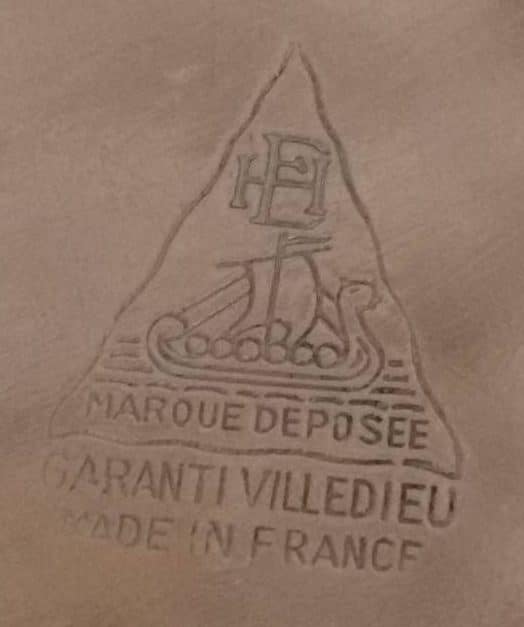 |
Triangle with ship, type IIIThis is almost the identical twin of Type II but there are fine differences. Compare for example the length of the horizontal “water” lines around the boat — the lines on this stamp are different lengths from the corresponding lines on the Type II stamp. I think this is the mark of a different physical stamp that was intended to replace a worn-out Type II stamp. I don’t have any firm information as to which of the twin stamps came first, but my hunch is that this is the replica stamp. Type II is slightly finer in design to my eye. |
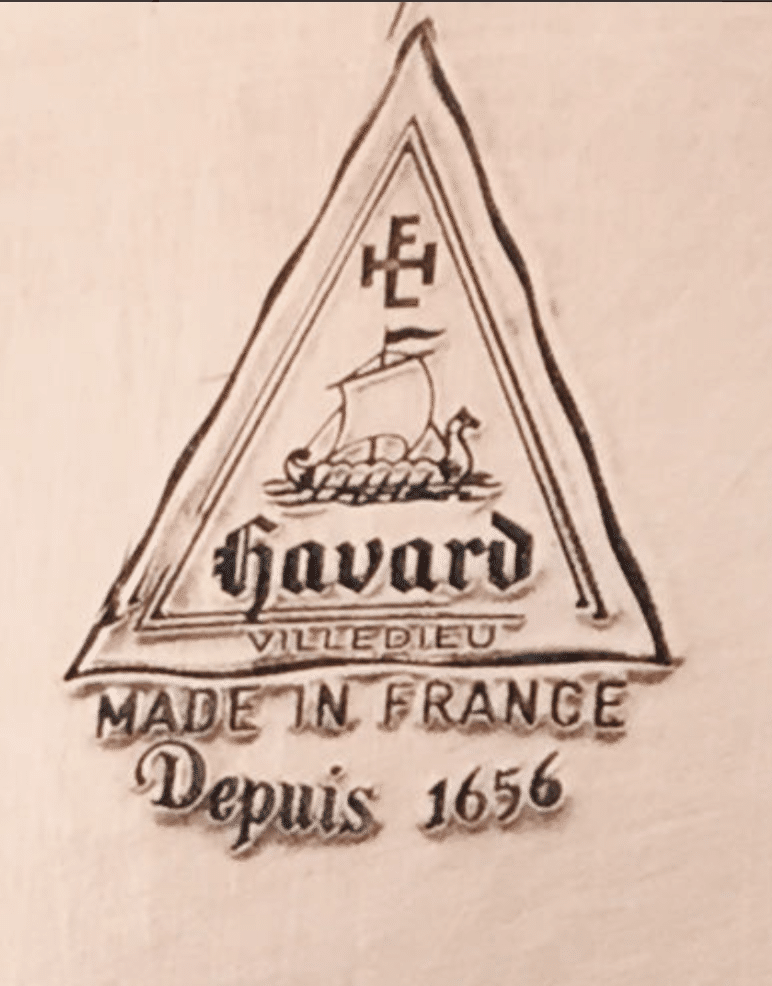 |
Triangle with ship, type IVI believe “Depuis 1656” refers to François Havard (1624-1688), bourgeois poêlier in Villedieu and ancestor to the Eugènes Havard. As do the Mauviels, the Havards recognize generations of family copper-making over centuries whether or not the companies themselves represent an unbroken line of succession. I’ve seen this stamp on pans lined with stainless steel, which dates it to the 1980s or later. It also discards the “Marque Deposée” and “Garanti Villedieu” notations, which seem to have fallen out of use on other pots and pans as well. It is possible that “depuis 1656” is intended as a jab at Mauviel, a comparative youngster at “since 1830.” |
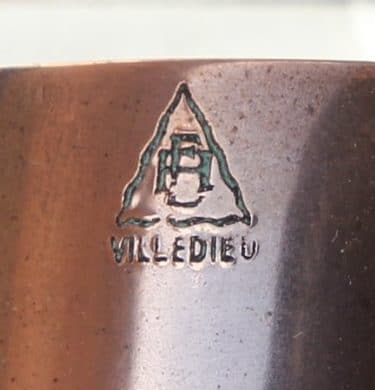 |
Simple triangleThis stamp is a very simple mark with the initials EH inside a triangle with the word Villedieu. I don’t know yet when this stamp came into use, but it would need a separate “Made in France” stamp for export. It’s possible this is a pre-1970s stamp. |
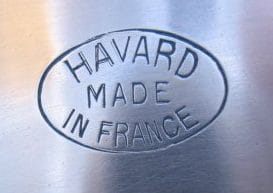 |
Simple ovalThis oval cartouche contains the words “Havard Made in France.” My guess is that this is a recent stamp but I’m continuing to survey what’s out there. |
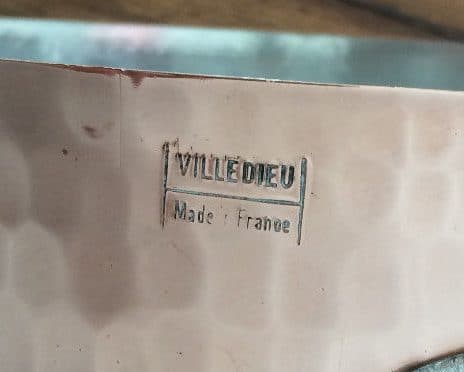 |
Villedieu (for Havard)This stamp does not say “Havard” on it, but with the help of reader Martin, I believe it is a Havard mark. It appears on pans that are physically identical to Havard pieces, and in addition, the lines form the letter H. I do not know for what purpose this stamp was made or when, but I suspect it is a fairly recent mark, perhaps 1980s to the 2000s. |
 |
Linear “Havard Villedieu”This linear stamp appears on lids, handle plates, and other small pieces where a larger stamp might not fit. I see this stamp on lids paired with pieces with the oval stamp and the small triangle stamp. |
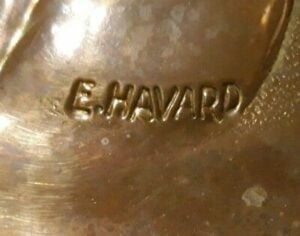 |
Linear “E. Havard”This is a Havard stamp used on decorative copper items — ashtrays, embossed serving trays, and other non-cookware items. |
Havard’s hammering
One distinctive element of Havard cookware is that many of the saucepans, saute pans and skillets have hammered bases, even when the sidewalls have a smooth finish. It’s a beautiful effect.
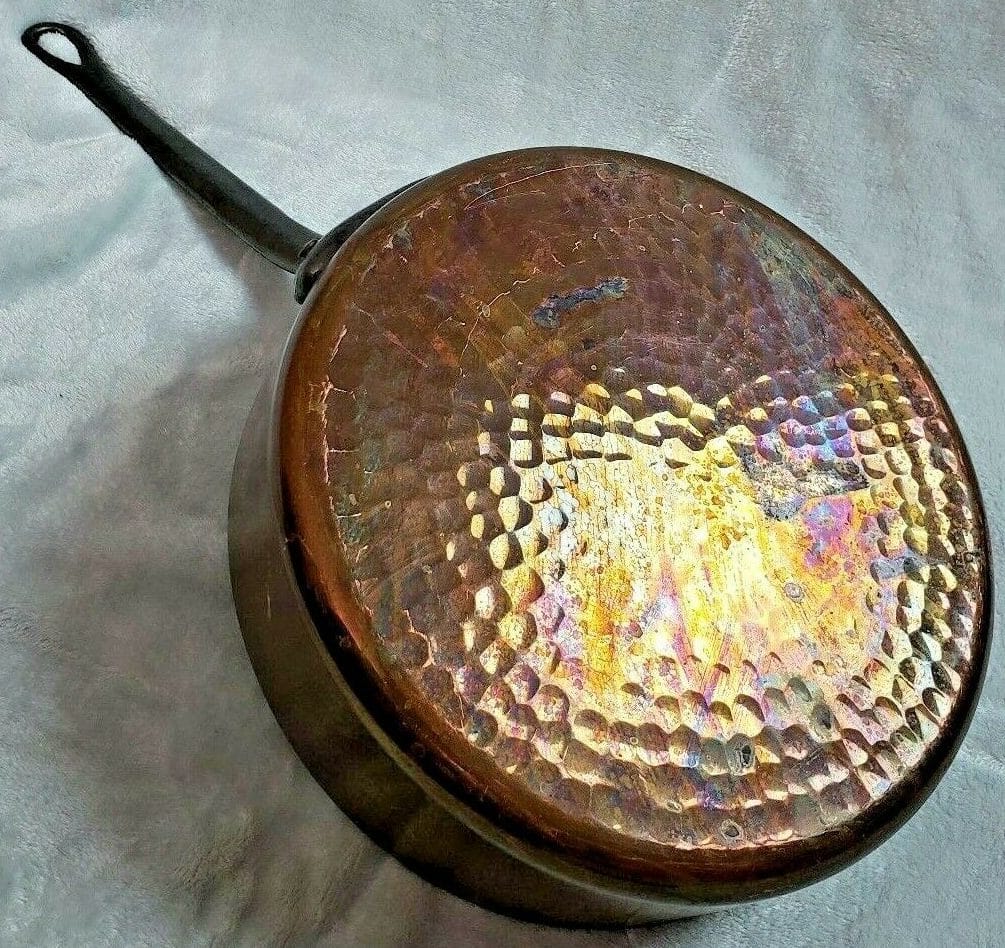
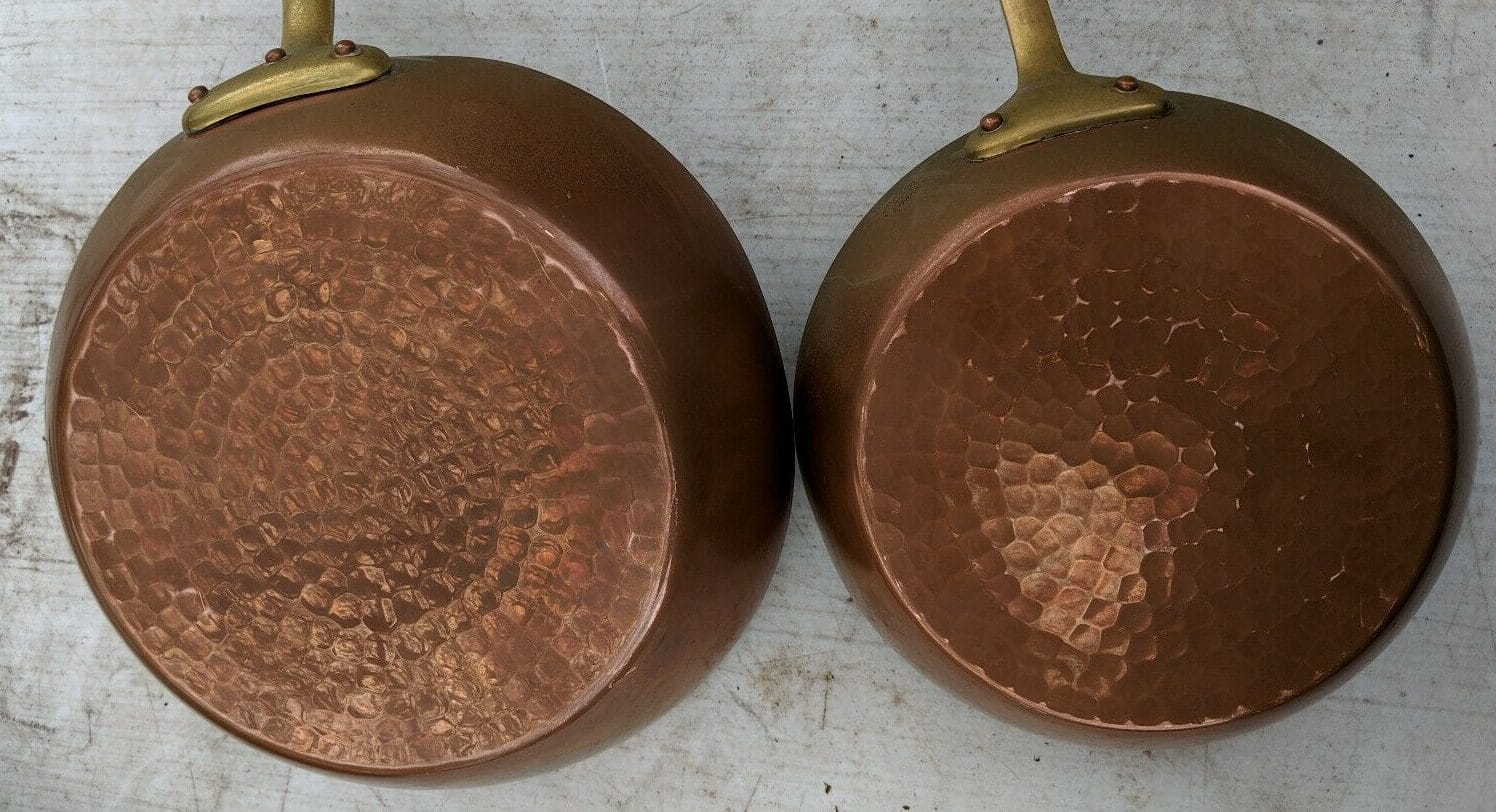
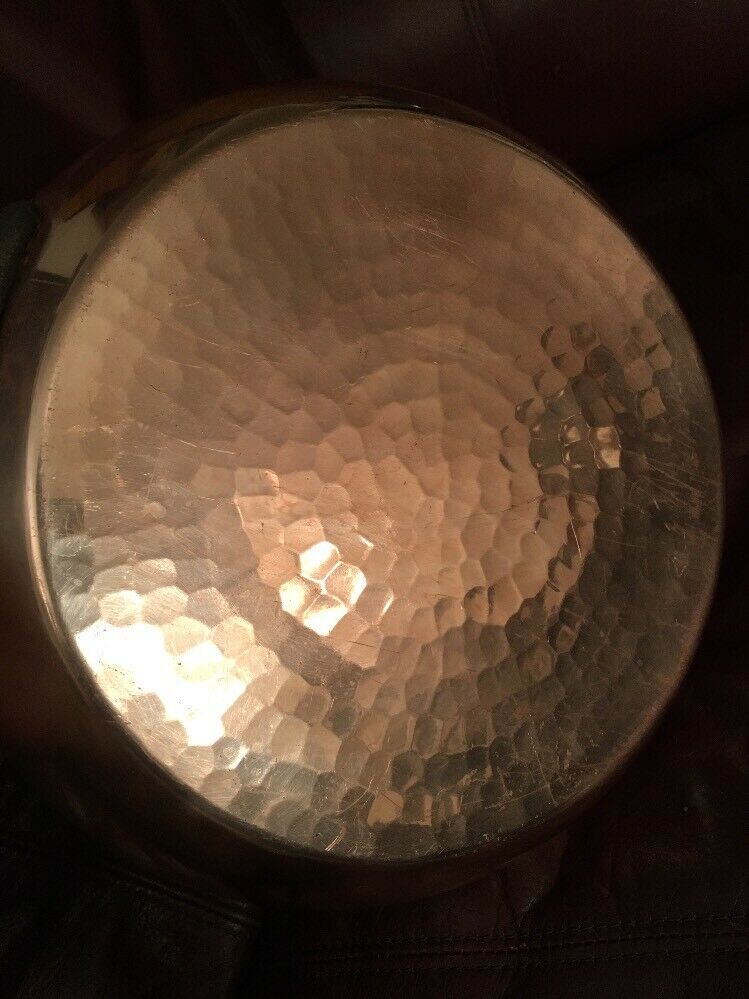
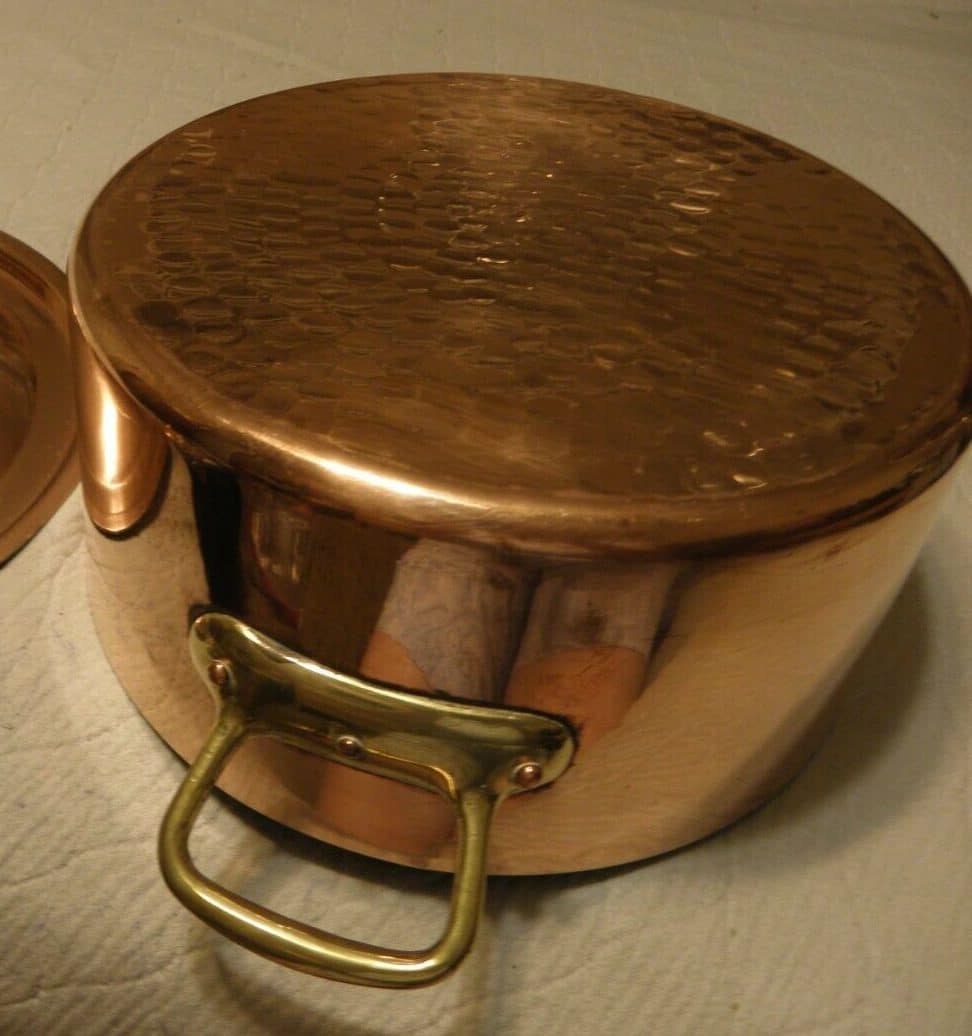
Conclusion
I’m continuing to learn about Havard’s history and the characteristics of its production over time, but a central question is who actually made the copper. My field guides hang on the premise that stamps are a reliable way to identify vintage copper, but I am coming to suspect that the different workshops supplied the different retail fronts over time. (This is why I also look at handles and hammering styles — stamps can come and go, but the hardware and craftsmanship of a piece of copper is immutable.)
I’ve reached out to Cornille-Havard with a series of questions about their history and production, particularly on the era of stamps and the workshops who supplied them. I will update this guide as I learn more.
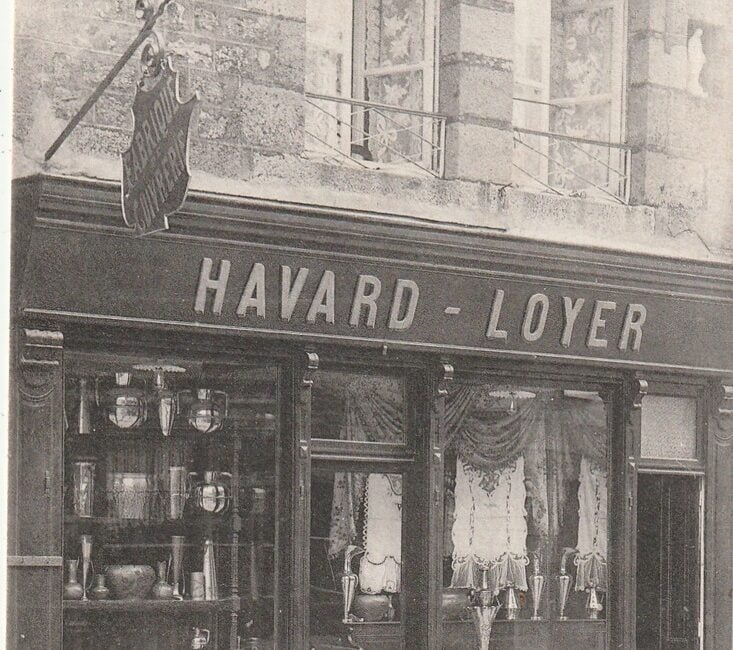
I found your history research fascinating with a wealth of knowledge, thank you so much as going to purchase a set of pans, and will always be reminded of your history information.
Hey, thank you! I am so glad the guide has been helpful for you. Enjoy your copper!
I picked up a 22cm saute with an oval Havard stamp recently, I’m wondering if it’s appropriate for cooking or whether it may just be more of a show piece. The rims measure roughly 2mm or just under, what do you think?
Josh, I agree with Roger’s comment. 2mm pans were “heavy grade” back in the day when people cooked over the hearth — but modern stovetops produce much more heat. Your 2mm sauté pan will heat quickly and efficiently, noticeably faster than steel or cast iron. When you begin to use it, start with a lower heat setting than you usually would and observe how the pan is performing — you will find that it reaches cooking temperature with lower heat than you might expect!
Hi Josh, 1.8 – 2mm is is not unusual, we like the thicker stuff of course but so long as the lining is good your pan should perform just fine. A lighter pan has the advantage being easy to wield and actually saute the food.
What you have is at least as good as the majority of new copper pans and although the cooking surface might vary in temperature a little the hot spots will be nowhere as bad as a pan made of a lesser material.
I have 2 Havard pots about 40 years old. Love their look and quality. Your site is a true joy to read. Thank you
Thank you George! Enjoy your beautiful copper!
https://www.ebay.com/itm/PAIR-OF-FRENCH-COPPER-PIN-DISHES-ASH-TRAY-ARTS-AND-CRAFTS-E-HAVARD/324217102060?hash=item4b7cd85eec:g:ygIAAOSwVLNe~b0i found this after using your guide and thought youd be interested
Hey June! Thank you! The Havard ashtrays in that listing carry that “E. HAVARD” stamp I’d only seen once before — this second examples suggests that it is indeed the stamp used on decorative copper. I’ve updated the field guide accordingly — thank you again for pointing it out!
Thank you for this informative piece! I am a direct descendant of Eugène Havard, through my great grandmother, Françoise Pauline Emilienne Havard, origine de Villedieu-les-Poêles… How cool … BTW I do believe the Havard line has been able to trace the ancestry back to 1066, fighting with Guillaume Le Conquérant during the Norman Invasion
Suzanne, thank you so much for visiting the site! I love your family’s work — they have made some of the most gorgeous copper I’ve ever seen. In fact the logo for this site — the little photo you see when I post or comment — is the hammered base of a piece that I believe to be Havard. I chose this photo for the way the hammering captures the light so beautifully, and to me that is the signature of Havard!
I am so glad you enjoyed this post and I would welcome any additions or corrections you’d like to contribute. Thank you again!
Merci beaucoup pour le travail historique que vous avez réalisé. J’ai une casserole Havard dont le timbre est proche mais différent. En outre, Viledieu est estampillé avec un seul « L » !
Comment puis-je vous envoyer une photo ?
Guy
Québec
Bonjour Guy! J’aimerais voir quelques photos. Je vous enverrai un e-mail directement. Merci!
I found your site because I was curious about the brass knob on my kitchen roll holder. It is very similar to your type IV but the wording is different. Between the outer and inner triangles along the bottom it says VILLEDIEU FRANCE, and then underneath the triangles it says Depuis 1656. I can’t remember when or where I bought the holder but it must have been between 1970 and 1990 or thereabouts. For such a mundane item, it’s very handsome!
Thank you for your field guide. Helped me identify a 16cm copper pot I found at a local thrift store.